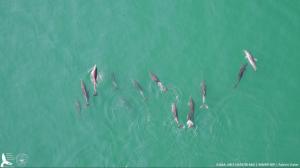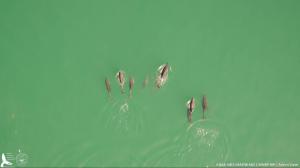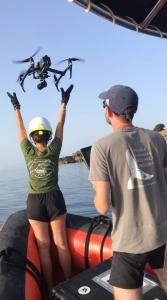UH researchers successfully use drones to find dolphin population health
University of Hawaiʻi at MānoaUsing drones to successfully assess the age of critically endangered, free-ranging dolphins in Greece is the focus of new research at the University of Hawaiʻi at Mānoa Hawaiʻi Institute of Marine Biology (HIMB). This work, done in partnership with the Tethys Research Institute, informs researchers’ understanding of population abundance and demographics, which can improve management practices and help ensure their survival. The study was published in Animal Conservation.
Marine Mammal Research Program (MMRP) researchers are comparing the drone imagery results with long-term data and data from stable, non-endangered bottlenose dolphin populations in Shark Bay, Australia, and Sarasota Bay, Florida.
“In [our new] study, we highlight the speed and accuracy of UAS-photogrammetry (drone imagery) in assessing the age structure of free-ranging dolphin populations, and the implications towards management and conservation,” said Fabien Vivier, MMRP researcher and lead author of the study. “Our hope is that by using this method, we can quickly monitor the age-structure of free-ranging dolphin populations. This information can facilitate the detection of early signs of population changes, such as a decrease in the number of calves, and provide important insights for timely management decisions.”
Healthy dolphin populations have a consistent proportion of calves, juveniles and adults; a deviation from this can suggest the population is unstable. Using drones, researchers were able to quickly quantify the age-structure of the critically endangered dolphin population in Greece in a few days.
Previous study classifies dolphin age
In a previous study, the MMRP team used specialized calibrated drones to successfully measure the length of free-swimming dolphins and classify them by age.
“When dolphins come to the surface to breathe, they expose their blowhole and dorsal fin,” said Vivier. “By measuring the distance between the two, we can estimate their total body length. Since total length is related to age, we can estimate the age-group of a single dolphin.”
Aquatic mammals known as cetaceans, which include whales, dolphins and porpoises, face a slough of threats from habitat degradation, climate change, fisheries, and chemical and noise pollution. One quarter of the 92 known cetacean species are at risk of extinction, and there is a clear and urgent need to implement effective conservation strategies.
The project was done in collaboration with the Shark Bay Dolphin Research Project and the Sarasota Dolphin Research Program. The work in Greece was funded by the Office of Naval Research (ONR), OceanCare and the Costas M Lemos Foundation. The work in Hawaiʻi is funded by ONR, NOAA Pacific Islands Fisheries Science Center, the Omidyar ʻOhana Fund at Hawaiʻi Community Foundation and Dolphin Quest.



